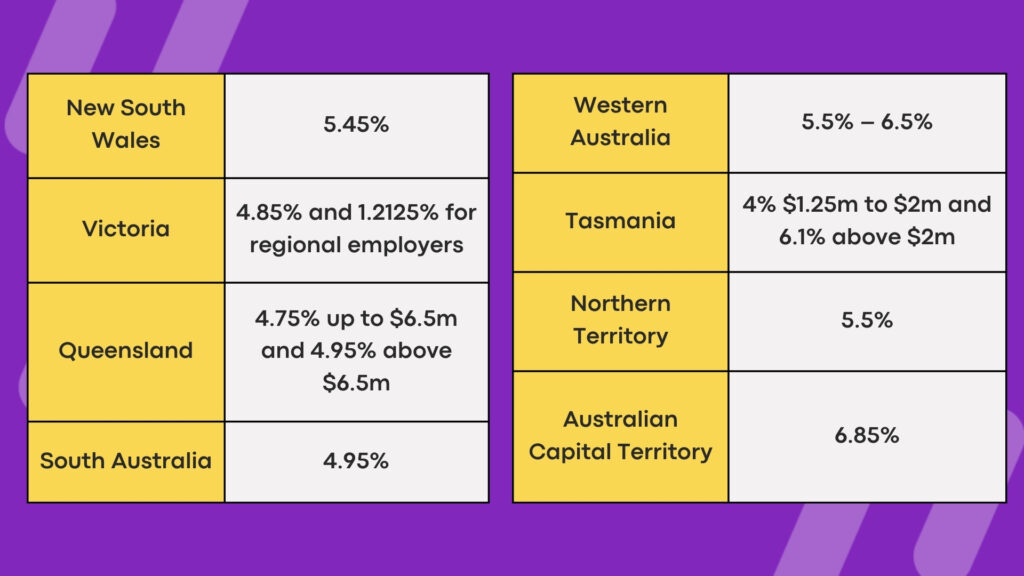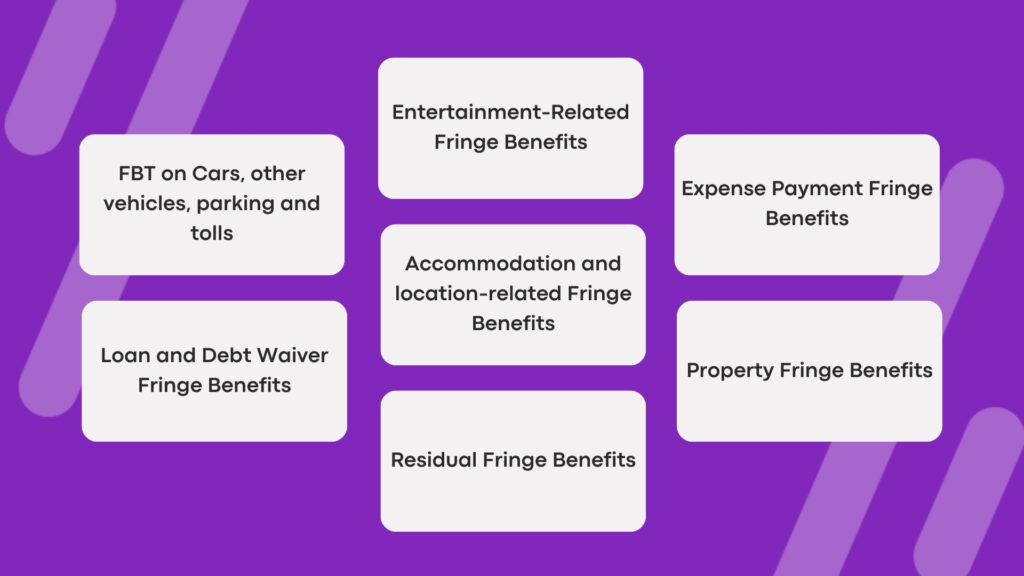Payroll taxes in Australia are a critical component of the tax landscape for employers. They represent the levy imposed on wages paid by businesses to their employees. This tax is calculated based on the total wage expenditure and is remitted to the respective state or territory revenue office. It is important for businesses to understand payroll taxes to ensure compliance and avoid penalties, as these taxes contribute significantly to state revenue and fund public services such as healthcare, education, and infrastructure.
Understanding the Australian Payroll Tax System
Australia’s payroll tax system is governed at the state and territory level, resulting in varying rates and thresholds across different regions. Each state sets its own tax-free threshold, above which payroll tax becomes payable.

The State-By-State overview of payroll taxes in Australia as of 2023.
Source: Tobin Partners
The Key Components of Payroll Taxes
There are several factors that determine the payroll taxes in Australia liability of a business, including:
Total Wages Paid: This includes salaries, wages, commissions, bonuses, allowances, and fringe benefits.
Thresholds* and Rates: These vary by state and impact when a business becomes liable for payroll tax and at what rate.
Exemptions and Concessions: Some wages are exempt from payroll tax, such as wages paid to employees on parental leave or to apprentices and trainees.
*The payroll tax threshold is the maximum annual wage bill a business can have without incurring payroll tax liability.
The Fringe Benefits Tax (FBT)
The Fringe Benefits Tax (FBT) is a tax employers pay on certain benefits they provide to their employees, including their families or associates. This tax is separate from income tax and is calculated on the taxable value of the fringe benefits provided. It aims to ensure that non-cash benefits are taxed similarly to cash wages, thereby promoting equity in the taxation system.

The types of Fringe Benefits (Per: The Australian Taxation Office)
The Goods and Services Tax (GST) and Its Role in Payroll
GST on Employee Remuneration
Generally, wages and salaries are not subject to Goods and Services Tax (GST). However, there are situations where GST implications may arise, such as with contractor payments where the contractor is GST-registered. Businesses need to distinguish between employees and contractors correctly to apply the appropriate GST treatment.
Input Tax Credits and GST Refunds
Businesses can claim input tax credits (ITCs) for the GST paid on expenses related to their taxable supplies. Proper record-keeping is essential to substantiate ITC claims and avoid potential disputes with the Australian Taxation Office (ATO).
Record-Keeping Requirements for GST
Accurate and detailed record-keeping is key to support GST claims. This includes maintaining tax invoices, receipts, and records of transactions. Failure to comply with record-keeping requirements can result in denied ITC claims and penalties.
Employer Superannuation Contributions
Superannuation Guarantee (SG) Rate and Obligations
Employers in Australia are required to make superannuation contributions on behalf of their employees, known as the Superannuation Guarantee (SG). As of 2024, the SG rate is 11%, with a planned increase to 12% by 2025. These contributions are calculated based on the employee’s ordinary time earnings and must be paid at least quarterly.
Choice of Superannuation Funds
Employees have the right to choose their superannuation fund. Employers must provide a standard choice form to new employees and contribute to their chosen fund or a default fund if no choice is made.
Contribution and Reporting Requirements
Employers must report superannuation contributions through Single Touch Payroll (STP) and meet their quarterly payment obligations. Contributions must be paid by the 28th day following the end of each quarter. Late payments may incur the Superannuation Guarantee Charge (SGC), which includes interest and administrative fees.
Payroll Benefits: Attracting and Retaining Top Talent
Employee benefits extend beyond salary and include a range of financial and non-financial perks designed to attract and retain talent. These can include salary packaging, superannuation enhancements, health insurance, annual leaves, stock options, flexible working hours, and many more.
A comprehensive and personally selected benefits package is a key driver of employee satisfaction and retention. It reflects the company’s commitment to the wellbeing of its workforce and can be tailored to meet the diverse needs of employees, contributing to a positive organizational culture.
Health Insurance: A Popular Benefit Option
Employers offering health insurance can benefit from tax deductions on premiums paid on behalf of employees. For employees, such benefits may be exempt from FBT if provided under certain conditions, such as for employees working in remote areas.
Selecting a suitable health insurance plan involves assessing factors such as coverage, cost, and employee needs. Offering comprehensive health benefits can improve employee satisfaction and reduce absenteeism.
Payroll Tax Compliance: Obligations and Penalties
Employers must be aware of their payroll tax obligations in Australia, which include registering with the relevant state revenue office, accurately calculating payroll tax liabilities, and lodging returns on time. Non-compliance can result in significant consequences for the company.
Comprehensive records of wages, superannuation contributions, and benefits provided must be maintained to support payroll tax returns. These records should be kept for at least five years and be readily available for review.
Single Touch Payroll (STP) and Reporting
Single Touch Payroll (STP) is an ATO initiative requiring employers to report wages, tax, and superannuation information each payday. STP simplifies compliance but requires businesses to use compatible software.
Industry-Specific Considerations
1. Payroll in Small Businesses
Small businesses often face challenges such as limited resources and expertise in managing payroll. Simplified payroll systems and outsourcing can help address these challenges and ensure compliance.
Simplified Payroll Systems
A user-friendly payroll software can simplify payroll management for small businesses. Key features to look for include automatic tax calculations, integration with accounting software, and compliance updates.
2. Payroll in Medium and Large Enterprises
Larger enterprises typically have dedicated payroll departments with defined roles such as payroll managers, compliance officers, and payroll clerks. Effective departmental structure and clear roles are essential for accurate and efficient payroll processing.
Pro Tip!
Outsourcing or using shared services can be beneficial for large enterprises, providing cost savings and access to specialized expertise. It can also enhance flexibility and scalability as business needs change.
3. Payroll in Non-Profit Organizations
Tax Deductibility
Non-profit organizations may have access to payroll tax exemptions or rebates, depending on their activities and state legislation. Understanding eligibility requirements is crucial for maximizing financial resources.
While volunteers are not typically subject to payroll tax, providing benefits such as reimbursements or honorariums may have tax implications. Non-profits must be aware of these rules to avoid unintentional tax liabilities.
By understanding the complexities of payroll taxes in Australia, employers can navigate compliance requirements, optimize their payroll processes, and create a supportive and rewarding work environment for their employees.
If you are looking for Payroll Expertise, Agile HRO might be your right-hand!
Contact Us Today!
Get Started with Agile
Schedule a 30-minute product demo with Q&A